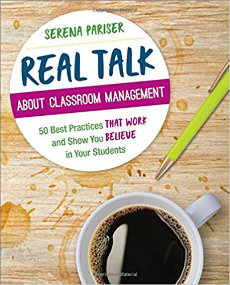50 Best Practices for Classroom Management
Real Talk About Classroom Management: 50 Best Practices That Work and Show You Believe in Your Students
By Serena Pariser
(Corwin, 2018 – Learn more)
Reviewed by Stacy Thorpe
Serena Pariser’s engaging book, Real Talk About Classroom Management, contains 50 best practices for creating a classroom community where the teacher is respected, students are valued and engaged, and isolation is reduced.
This book is divided into six sections: First Weeks of School, Forming Positive Relationships with Your Students, Curriculum and Instruction, Other Adults as Resources, Spins That Will Wow Your Students, and Keeping Yourself Sane.

Part 1: The First Weeks of School has five best practices for starting the school year off right. Pariser provides practical advice for learning student names, earning respect, setting up routines and engaging students.
Best practice #4: Speak Student includes tips for improving how we speak to students and how to keep your interactions positive and powerful. Pariser stresses the importance of using “I statements” and student names when communicating to keep interactions helpful rather than harmful.
Part 2: Forming Positive Relationships with Your Students begins with a ‘what not to do’ story about a teacher who placed a talkative student in the closet. In this day and age, I think most teachers realize that pulling this kind of stunt will probably render you unemployed, but how do we deal with tough or difficult students in the classroom? This section contains nine best practices for getting students on your side and helping them develop skills that allow them to be contributing members of the classroom community.
Best practice #13: Reward Students describes how to use rewards to promote success in the classroom while focusing on the fact that you want them to succeed. One of the questions for reflection asks “Did you ever have a project in middle or high school that had a competitive edge? Did that make you work harder? Why or why not?”
Part 3: Curriculum and Instruction is the largest section of the book; after all, the overall goal of school is that students learn! There are 15 practices in this section for designing instruction to keep students engaged, challenged and appropriately supported.
Best practice #21: Challenge and Support Students compares meeting the needs of each student to Goldilocks and the Three Bears; we must provide the ‘just right’ amount of challenge and scaffolding for each student in order to keep them engaged.
Part 4: Other Adults as Resources shares best practices for getting parents on board and collaborating with colleagues. Pariser reminisces on her mistake of investing so much into the classroom and students that she missed out on important interactions with coworkers.
This section leads off with a personal reflection from Jennifer Zimmermaker, an Educational Specialist, in which she describes ten tools to keep your sanity intact when dealing with difficult families – and practical advice for interacting with parents when tough situations arise in the classroom.
Part 5: Spins that Will WOW Your Students has nine best practices for adding pizzazz to your class. Best Practice #40: Laugh Together and You Will Learn Together describes how laughter helps you be more productive and develop stronger relationships in the classroom. Pariser suggests ideas for having a stuffed class pet, handing out hilarious gag-gift prizes, and telling funny stories in class. A quote from one of Pariser’s 8th grade students: “This is the funniest class I’ve ever been in.”
Part 6: Keeping Yourself Sane gives personal advice about maintaining a work-life balance. Pariser explains, through the final five best practices, that it is important for teachers to be personally balanced in order to provide the best for students.
Best Practice #46: Balance Your Life gives 7 Tips for Keeping Your Balance including exercising, prioritizing, and separating your work from your personal life. My favorite tip was giving yourself a “Get out of Jail Free Card,” permission to skip grading non-essential assignments once in a while in order to clear your desk of an overwhelming amount of tasks.
The book concludes with a “Handy To-Go List of 50 Teaching Dos and Don’ts,” a concise description of each best practice, and a handy reference for reviewing the strategies.
The cool teacher next door!
When I finished this book, I immediately went to Twitter and followed Serena Pariser. Her writing style and practical suggestions made her seem like the cool teacher next door who has great experience with challenging situations. Very fitting that there is an image of a coffee mug on the front cover of this book – I felt like I was sitting down with a friendly colleague who had funny stories and great advice to share.
Stacy Thorpe teaches Special Education in Gobles, Michigan. She recently completed her Master’s degree in Learning Disabilities at Spring Arbor University. She is always trying to find new ways to help ALL students grow and learn. When she is not teaching or researching, Thorpe is spending time with her husband and three sons: cheering them on in sporting events, enjoying their musical performances, supporting their involvement on Solar Car and Robotics Teams, and enjoying family campouts.





































